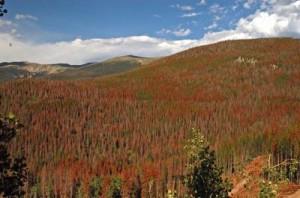
Doubters and climate change believers, draw near. Scientists have collated new data about climate change, and this is probably the most stunning news ever.
According to tree-ring growth data combined with historical information, climate records, and computer-model projections of future climate trends, widespread tree death is likely, researchers report this week in the journal Nature Climate Change.
A group of scientists from Los Alamos National Laboratory, the U.S. Geological Survey, the University of Arizona and other groups used this data from 13,000 tree core samples with known temperature and moisture data. They also blended events from archaeological and other paleorecords, such as the late 1200s megadrought that drove the ancient Pueblo Indians out of longtime settlements such as those at Mesa Verde, Colo. The result was a new “drought index†to help them measure the combined effects of drought and disease.
“This new drought index has the strongest correlation with combined tree growth, tree death from drought and insects, and area burned by forest fires that I have ever seen,” says co-author Thomas W. Swetnam, director of the UA Laboratory of Tree-Ring Research.
By comparing the tree-ring record to climate data collected in the Southwest since the late 1800s, the scientists identified two climate variables that estimate annual southwestern tree-growth variability with exceptional accuracy: total winter precipitation and average summer-fall atmospheric evaporative demand, a measure of the overall dryness of the environment.
“Atmospheric evaporative demand is primarily driven by temperature. When air is warmer, it can hold more water vapor, thus increasing the pace at which soil and plants dry out. The air literally sucks the moisture out of the soil and plants,†says A. Park Williams of Los Alamos National Laboratory in New Mexico, the lead author of the paper.
These trends, the researchers noted, are already occurring in the Southwest, where temperatures generally have been increasing for the past century and are expected to continue to do so because of accumulating greenhouse gases in the atmosphere.
There still will be wet winters, but increased frequency of warmer summers will put more stress on trees and limit their growth after wet winters, the study reports.
“We can use the past to learn about the future,” Williams said. “For example, satellite fire data from the past 30 years show that there has been a strong and exponential relationship between the regional tree-ring drought-stress record and the area of southwestern forests killed by wildfire each year. This suggests that if drought intensifies, we can expect forests not only to grow more slowly, but also to die more quickly.”
The study points out that very large and severe wildfires, bark-beetle outbreaks and a doubling of the proportion of dead trees in response to early 21st-century warmth and drought conditions are evidence that a transition of southwestern forest landscapes toward more open and drought-tolerant ecosystems may already be underway.
“When we look at our tree-ring record, we see this huge dip in the 1580s when all the tree rings are really tiny,” Williams said. “Following the 1500s megadrought, tree rings get wider, and there was a major boom in new trees. Nearly all trees we see in the Southwest today were established after the late-1500s drought, even though the species we evaluated can easily live longer than 400 years. So that event is a benchmark for us today. If forest drought stress exceeds late 1500 levels, we expect that a lot of trees are going to be dying.”
Sorry. I have no smartass remark to add to this. Just sucks to be us, I guess.